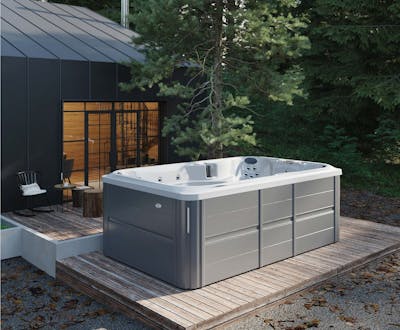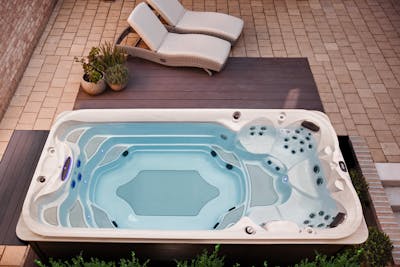Climate Adaptability
Swim spas adapt better to varying climate conditions throughout the year. The compact size and efficient systems maintain consistent temperatures for both exercise and relaxation, while pools struggle with temperature regulation during transitional seasons.
This adaptability extends the practical value of your investment, ensuring consistent family enjoyment rather than seasonal limitation that characterizes most pool installations.
Maintenance Requirements
Daily and seasonal maintenance demands significantly impact the long-term ownership experience, affecting both time commitment and ongoing costs for busy families.
Swim Spa Maintenance Advantages
Swim spas offer streamlined maintenance thanks to rapid water circulation that filters the entire volume every 15 minutes. This frequent filtration quickly removes contaminants and maintains water clarity with minimal chemical intervention.
The smaller water volume means reduced chemical consumption and simpler balancing procedures. Most swim spa owners spend 30-50% less time on weekly maintenance compared to pool owners, while achieving superior water quality.
Traditional Pool Maintenance Demands
Pool maintenance requires significant weekly time investment for chemical balancing, debris removal, vacuuming, and equipment monitoring. The large water volume takes 12-18 hours to complete a full filtration cycle, allowing contaminants more time to create problems.
Seasonal maintenance adds complexity, including winterization procedures, equipment protection, and spring opening processes that many families find overwhelming. These tasks often require professional service, adding to long-term costs.
Water Quality Management
The rapid filtration cycle in swim spas creates consistently cleaner water with reduced algae growth potential. Smaller surface area means less debris collection, while efficient circulation prevents stagnant zones where problems develop.
Pool water quality depends on longer filtration cycles and higher chemical doses to maintain clarity. The larger surface area collects more organic debris, requiring vigilant maintenance to prevent water quality issues that can shut down swimming activities.
Swimming and Fitness Features
The core question of swimming experience often determines whether families choose traditional pools or modern swim spa technology for their fitness and recreation needs.
Swim Spa Current Technology
Modern swim spas use sophisticated current generation systems that create adjustable water flow for endless swimming. Jacuzzi and other premium manufacturers offer variable speed controls that challenge experienced swimmers while accommodating beginners.
The consistent current provides a more focused workout than traditional pool swimming, eliminating turns and allowing sustained cardiovascular exercise. Many swimmers find the resistance training benefits superior to standard pool laps.
Traditional Pool Swimming Experience
Pools excel for families who enjoy swimming variety, including diving, games, and unrestricted movement. The open space supports multiple swimming styles and allows several people to swim simultaneously without interference.
For serious lap swimmers, pools provide the traditional experience many prefer, including the ability to practice turns, judge distances, and swim extended sets without current assistance.
Fitness and Exercise Options
Swim spas integrate additional fitness features beyond swimming, including resistance bands, rowing attachments, and aqua fitness accessories. The adjustable current supports various exercise intensities, from gentle water walking to high-intensity training.
Traditional pools primarily support swimming-based fitness, though their larger size accommodates water aerobics classes and group activities that swim spas cannot match due to space limitations.
Aquatic Therapy Benefits
The combination of warm water, adjustable current, and compact size makes swim spas ideal for physical therapy and rehabilitation. Many families choose swim spas specifically for injury recovery, arthritis management, or low-impact exercise programs.
While pools can support therapeutic exercise, they typically lack the targeted features and temperature control that make swim spas more effective for health-focused applications.
Entertainment and Family Use
Family dynamics and entertaining preferences significantly influence the pool vs swim spa decision, as each option serves different social and recreational needs.
Pool Party and Social Capacity
Traditional pools dominate for large gatherings, comfortably accommodating 10 or more people for pool party events, children’s birthdays, and neighborhood socializing. The open space supports games, floating devices, and active play that creates memorable family experiences.
Diving boards, slides, and other recreational features enhance the entertainment value, particularly for families with kids who enjoy active water play. The visual impact of a sparkling pool creates an impressive backdrop for outdoor entertaining.
Swim Spa Social Dynamics
Swim spas typically accommodate 4-6 people comfortably, creating more intimate social experiences. The seating areas and spa-like atmosphere appeal to adults seeking relaxation and conversation rather than active play.
Many families appreciate the opportunity to relax together in warm water year round, creating consistent opportunities for family bonding that don’t depend on weather or season.
Child Safety Considerations
Both options require careful safety planning, but swim spas offer some advantages for families with young children. The smaller water volume, consistent depth, and easy-to-secure covers simplify supervision and access control.
Traditional pools require comprehensive safety measures including fencing, alarms, and covers to meet regulatory requirements and protect children. The larger water volume and varied depths create more complex safety considerations.
Multi-Generational Appeal
Swim spas often better serve multi-generational families, offering gentle exercise options for older adults while providing fun for younger family members. The therapeutic warm water appeals to grandparents, while kids enjoy the current and jets.
Traditional pools excel when multiple generations want to enjoy swimming together, providing space for various activities and comfort levels without crowding or interference.
Property Value and Aesthetics
The long-term impact on your home’s value and visual appeal represents an important consideration that affects both immediate enjoyment and future resale potential.
Home Value Impact Analysis
A professionally installed in ground pool can increase home value by 5-8% in favorable markets, particularly in warm climates where pools are highly desirable. However, this return varies significantly by region and local market preferences.
Swim spas typically do not materially affect property valuation for appraisal purposes, but they offer portability that allows you to take your investment when you move. This flexibility appeals to families who may relocate or want to upgrade later.
Design Integration Options
Traditional pools offer maximum design flexibility, supporting custom shapes, materials, and integrated landscaping that creates resort-like backyard environments. The permanent installation allows for sophisticated lighting, water features, and architectural integration.
Swim spas provide more limited aesthetic options due to their prefabricated nature, but creative landscaping, decking, and pergola installations can achieve attractive integration with existing outdoor spaces.
Neighborhood Considerations
In upscale neighborhoods, a quality pool installation may be expected and enhance property competitiveness. However, some areas prefer the cleaner lines and modern efficiency that swim spas represent.
The visual impact varies by personal preference and neighborhood character. Traditional pools make bold statements, while swim spas offer subtler integration that preserves yard space for other activities.
Long-Term Flexibility
Swim spas provide unique flexibility for changing needs or property modifications. If you decide to renovate, expand your home, or reconfigure outdoor spaces, the portable swim spa can adapt to new layouts.
Traditional pools represent permanent commitments that define backyard use for decades. While this permanence appeals to some families, others prefer the adaptability that swim spas offer.

















